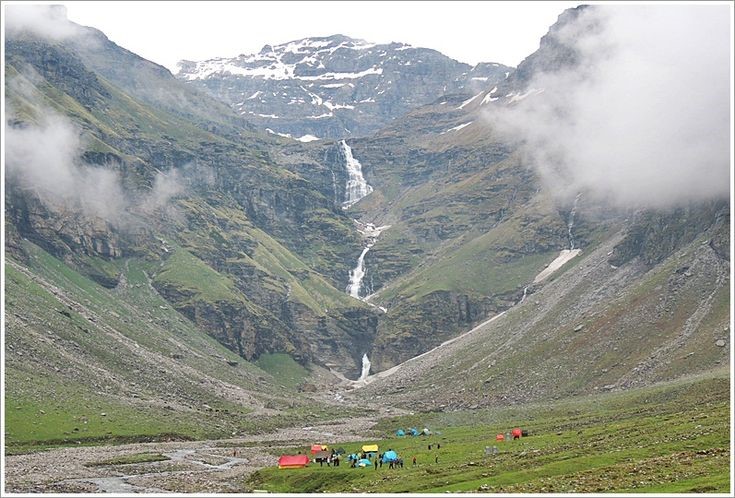Introduction
The Rupin Pass Trek stands as a testament to the unparalleled beauty nestled in the heart of the Himalayas. This journey through the pristine wilderness offers not only a physical challenge but a soul-stirring experience. Imagine the thrill of conquering the Rupin Pass, surrounded by breathtaking landscapes that seem to belong to a different world. In this article, we will delve deeper into the nuances of this trek, from the essential preparations to the unforgettable moments that await at the pinnacle of the pass.
Preparing for the Journey
Before setting foot on the trail, thorough preparation is key. Gathering the right gear, including sturdy trekking boots, a reliable backpack, and weather-appropriate clothing, ensures you are equipped to face the diverse conditions of the Himalayas. Additionally, physical fitness is paramount. Regular cardio and strength training exercises in the weeks leading up to the trek build endurance, preparing you for the challenges that lie ahead.
The Enchanting Starting Point: Dhaula
The journey begins at Dhaula, a quaint village that serves as the gateway to the Rupin Pass. The beauty of Dhaula lies not only in its surroundings but also in the warmth of its people. Take some time to immerse yourself in the local culture and traditions, creating a connection with the place and its residents. This cultural prelude sets the tone for the adventure that unfolds with each step.
Dhaula is more than a mere starting point; it’s a cultural immersion. The village, with its traditional houses and vibrant markets, provides a glimpse into the local way of life. Trekkers often find themselves captivated by the simplicity and authenticity of Dhaula, making it more than just a logistical necessity but an integral part of the trekking experience.
Traversing the Trail: Day-wise Itinerary
The day-wise itinerary is a roadmap to the adventure, guiding trekkers through a mesmerizing journey. Each day brings new landscapes and challenges, from the initial trek from Dhaula to Sewa, Jiskun, and beyond. The diversity of the terrain, including lush green meadows, dense forests, and rocky slopes, keeps the trek exciting and ever-changing.
As you progress through the days, the trail unfolds like a story, revealing different chapters of the Himalayan wilderness. The transition from the lower altitudes, adorned with rhododendron forests, to the higher reaches with panoramic views of snow-capped peaks is a narrative written by nature itself. Each campsite, strategically placed for both practicality and scenic beauty, becomes a temporary home amidst the vast expanse.
Flora and Fauna Along the Trail
The Rupin Pass Trek is not just a physical challenge; it’s a botanical and zoological expedition. As you ascend, witness the transition in vegetation, from dense forests of oak and pine to alpine meadows adorned with vibrant flowers. Look out for the varied wildlife, which includes several bird species and the elusive Himalayan tahr.
The diversity of flora along the trail is astounding. The lower regions are adorned with rhododendron blooms, creating a vibrant tapestry of colors. As you ascend, the landscape changes, giving way to hardy alpine plants that have adapted to the harsh mountain conditions. This botanical diversity adds an extra layer of fascination to the trek, as each day reveals a new palette of colors and scents.
The Rupin Pass Elevation’s Benefits and Risks
Undoubtedly, the trek poses challenges. The steep ascents and descents, especially as you approach the pass, test your physical endurance and mental resilience. Yet, with each challenge comes a rewarding view. The panoramic vistas from the pass, with snow-clad peaks and expansive valleys, make every arduous step worthwhile.
The challenges of the Rupin Pass Trek are not just physical; they are a test of determination and mental strength. The ever-changing weather, the demanding altitudes, and the rugged terrain demand adaptability. However, conquering these challenges brings a profound sense of accomplishment, fostering a connection with the raw power of nature.
Camping Amidst Nature: A Unique Experience
Camping along the trail is an adventure in itself. Setting up tents in the lap of nature, surrounded by snow-capped peaks and the symphony of nature, creates a unique connection with the environment. The camping experience is more than just a night’s rest; it’s a chance to become part of the landscape.
As the sun sets behind the mountains, painting the sky in hues of orange and pink, the transition from day to night is a spectacle. The temperature drops, and the stars emerge, casting a celestial glow over the Himalayan peaks. These are the moments that make camping on the Rupin Pass Trek an experience to cherish.
Local Cuisine and Hospitality
The journey is not just about the landscapes but also about the people you encounter. Experience the hospitality of the locals and indulge in the flavors of traditional Himalayan cuisine. From hearty dal and rice to local delicacies, every meal is a cultural exploration.
Local cuisine adds a delightful dimension to the trek. The simplicity of the ingredients and the traditional methods of preparation showcase the essence of the Himalayan way of life. Trekkers often find themselves savoring local specialties around the communal dining area, sharing stories with fellow adventurers and the welcoming locals.
Keeping Memories Alive: Photography Advice
For photography enthusiasts, the Rupin Pass Trek is a visual feast. From sunrise over the snow-covered peaks to the play of light and shadow on the landscapes, every moment is a frame-worthy composition. Ensure your camera is ready to capture the awe-inspiring beauty of the Himalayas.
Photography becomes a medium to encapsulate the essence of the trek. The changing hues of the landscape, the camaraderie among trekkers, and the local interactions are moments frozen in time through the lens. As you trek through the diverse terrain, each frame tells a part of the story, creating a visual narrative of your Rupin Pass adventure.
Ecological Preservation and Conscientious Hiking
As adventurers, it’s our responsibility to tread lightly. The fragile ecosystems of the Himalayas require our care and attention. Adopting Leave No Trace principles, minimizing waste, and respecting local customs contribute to the preservation of this pristine wilderness.
Responsible trekking is not just an ethical choice; it’s a commitment to the long-term sustainability of these fragile environments. Trekkers are encouraged to minimize their environmental impact by following designated trails, avoiding littering, and being mindful of the flora and fauna. By embracing responsible trekking practices, adventurers play a vital role in ensuring that future generations can also experience the beauty of the Rupin Pass and its surroundings.
Weather and Best Time to Visit
Understanding the seasonal variations is crucial for a successful trek. The weather in the Himalayas can be unpredictable, with snowfall even in the summer months. The ideal time to undertake the Rupin Pass Trek is during the pre-monsoon months of May to June and the post-monsoon months of September to October when the weather is relatively stable.
The Himalayan weather adds an element of unpredictability to the trek. Trekkers may encounter a variety of weather conditions, from clear skies and pleasant temperatures to sudden snowfall and chilly winds. Being prepared for these variations ensures a more enjoyable and safer experience on the trail.
Embark on the adventure of a lifetime with The Searching Souls , your trusted partner for Rupin Pass Trek. Experience breathtaking landscapes, expert guidance, and unparalleled service as you conquer this Himalayan marvel.
Safety Measures and Emergency Protocols
While the allure of the Himalayas is undeniable, safety should always be a priority. Trekkers should acclimatize gradually to the high altitudes, stay hydrated, and be aware of their physical well-being. Basic medical facilities are available at certain points along the trail, but carrying a well-equipped first aid kit is advisable. Get acquainted with the procedures and emergency contact information.
High-altitude trekking comes with its set of challenges, and being prepared is essential. Trekkers should be aware of the symptoms of altitude sickness and take necessary precautions. Adequate hydration, proper acclimatization, and understanding the signs of altitude-related illnesses contribute to a safer and more enjoyable trekking experience.
Getting in Touch with Other Trekkers
One of the unique aspects of the Rupin Pass Trek is the camaraderie built among fellow trekkers. Shared challenges, moments of triumph, and the sheer joy of conquering the pass create bonds that often extend beyond the trek itself. Take the time to connect, share stories, and appreciate the diverse backgrounds of your fellow adventurers.
The community formed on the trail is a microcosm of shared aspirations and mutual support. As trekkers navigate the challenges together, whether it’s assisting in setting up a campsite or offering encouragement during a steep ascent, a sense of unity emerges. These connections often result in lifelong friendships, as the shared experience of the Rupin Pass Trek fosters a unique camaraderie.
Reflections on Personal Growth
Beyond the physical and mental challenges, the Rupin Pass Trek offers a journey of personal growth and self-discovery. As you navigate the heights and push your limits, reflect on the lessons learned, the inner strength discovered, and the transformative nature of the trek.
The trek becomes a metaphor for personal growth. Each step is not just a physical movement but a conscious choice to overcome challenges. The solitude of the mountains provides a backdrop for introspection, allowing trekkers to confront their limitations and discover untapped reservoirs of strength. The Rupin Pass becomes more than a geographical location; it becomes a marker of personal achievement and resilience.
Conclusion
In conclusion, the Rupin Pass Trek is not just an adventure; it’s a transformative journey through the pristine Himalayan wilderness. From the enchanting starting point in Dhaula to the challenges and rewards of the trail, every step contributes to an experience that transcends the ordinary. As you contemplate the vastness of the Himalayas, consider embarking on this odyssey of self-discovery and exploration.
The Rupin Pass Trek is more than a physical feat; it’s a narrative of nature’s grandeur, cultural richness, and personal triumph. It beckons adventurers to step out of their comfort zones, embrace the unknown, and immerse themselves in the unparalleled beauty of the Himalayas.
FAQs
Is the Rupin Pass Trek suitable for beginners?
While challenging, the trek is suitable for those with a moderate level of fitness and some trekking experience.
What is the best time to undertake the Rupin Pass Trek?
The ideal months are May to June and September to October when the weather is relatively stable.
Are there medical facilities along the trail?
Basic medical facilities are available at certain points, but trekkers are advised to carry a basic first aid kit.
How do I acclimatize to the high altitude?
Gradual ascent, proper hydration, and paying attention to your body’s signals are key to acclimatization.
What is the difficulty level of the Rupin Pass Trek?
The trek is considered moderately difficult, with challenging terrains and steep ascents.


